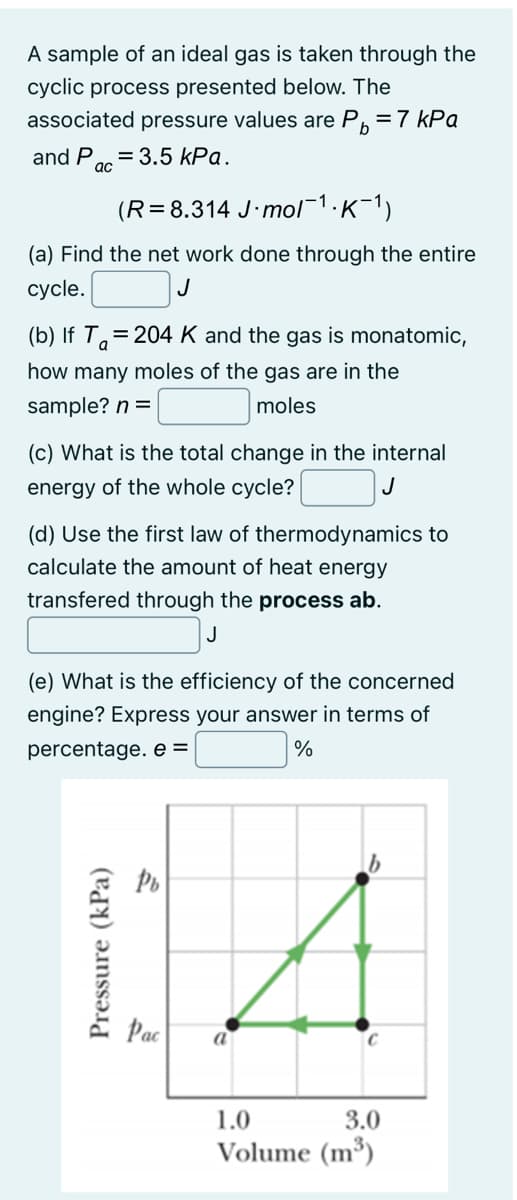A sample of an ideal gas is taken through the cyclic process presented below. The associated pressure values are P, =7 kPa and P ас = 3.5 kPa. (R=8.314 J mol1.K-1) (a) Find the net work done through the entire сycle. (b) If T,= 204 K and the gas is monatomic, how many moles of the gas are in the sample? n = moles (c) What is the total change in the internal energy of the whole cycle? J (d) Use the first law of thermodynamics to calculate the amount of heat energy transfered through the process ab. J (e) What is the efficiency of the concerned engine? Express your answer in terms of percentage. e = % Pac a 1.0 3.0 Volume (m³) Pressure (kPa)
A sample of an ideal gas is taken through the cyclic process presented below. The associated pressure values are P, =7 kPa and P ас = 3.5 kPa. (R=8.314 J mol1.K-1) (a) Find the net work done through the entire сycle. (b) If T,= 204 K and the gas is monatomic, how many moles of the gas are in the sample? n = moles (c) What is the total change in the internal energy of the whole cycle? J (d) Use the first law of thermodynamics to calculate the amount of heat energy transfered through the process ab. J (e) What is the efficiency of the concerned engine? Express your answer in terms of percentage. e = % Pac a 1.0 3.0 Volume (m³) Pressure (kPa)
Chapter3: The First Law Of Thermodynamics
Section: Chapter Questions
Problem 93CP: An insulated vessel contains 1.5 moles of argon at 2 atm. The gas initially occupies a volume of 5...
Related questions
Question
Solve step by step and quick

Transcribed Image Text:A sample of an ideal gas is taken through the
cyclic process presented below. The
associated pressure values are P =7 kPa
and P
= 3.5 kPa.
ас
(R=8.314 J·mol¯1.K-1)
(a) Find the net work done through the entire
сycle.
J
(b) If T.=204 K and the gas is monatomic,
how many moles of the gas are in the
sample? n =
moles
(c) What is the total change in the internal
energy of the whole cycle?
J
(d) Use the first law of thermodynamics to
calculate the amount of heat energy
transfered through the process ab.
J
(e) What is the efficiency of the concerned
engine? Express your answer in terms of
percentage. e =
Pac
a
1.0
3.0
Volume (m³)
Pressure (kPa)
Expert Solution
This question has been solved!
Explore an expertly crafted, step-by-step solution for a thorough understanding of key concepts.
This is a popular solution!
Trending now
This is a popular solution!
Step by step
Solved in 2 steps with 1 images

Knowledge Booster
Learn more about
Need a deep-dive on the concept behind this application? Look no further. Learn more about this topic, physics and related others by exploring similar questions and additional content below.Recommended textbooks for you


Physics for Scientists and Engineers: Foundations…
Physics
ISBN:
9781133939146
Author:
Katz, Debora M.
Publisher:
Cengage Learning

Principles of Physics: A Calculus-Based Text
Physics
ISBN:
9781133104261
Author:
Raymond A. Serway, John W. Jewett
Publisher:
Cengage Learning


Physics for Scientists and Engineers: Foundations…
Physics
ISBN:
9781133939146
Author:
Katz, Debora M.
Publisher:
Cengage Learning

Principles of Physics: A Calculus-Based Text
Physics
ISBN:
9781133104261
Author:
Raymond A. Serway, John W. Jewett
Publisher:
Cengage Learning